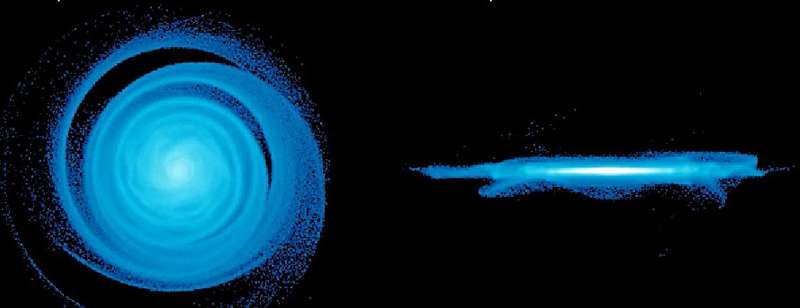This article has been reviewed according to Science X's editorial process and policies. Editors have highlighted the following attributes while ensuring the content's credibility:
fact-checked
peer-reviewed publication
trusted source
proofread
Astronomers detect seismic ripples in ancient galactic disk

A new snapshot of an ancient, far-off galaxy could help scientists understand how it formed and the origins of our own Milky Way. At more than 12 billion years old, BRI 1335-0417 is the oldest and furthest known spiral galaxy in our universe.
Lead author Dr. Takafumi Tsukui said the state-of-the-art telescope ALMA allowed them to look at this ancient galaxy in much greater detail.
"Specifically, we were interested in how gas was moving into and throughout the galaxy," Dr. Tsukui said. "Gas is a key ingredient for forming stars and can give us important clues about how a galaxy is actually fueling its star formation."
In this case, the researchers were able to not only capture the motion of the gas around BRI 1335-0417, but also reveal a seismic wave forming—a first in this type of early galaxy. The study has been published in Monthly Notices of the Royal Astronomical Society.
The galaxy's disk, a flattened mass of rotating stars, gas and dust, moves in a way not dissimilar to ripples spreading on a pond after a stone is thrown in.
"The vertically oscillating motion of the disk is due to an external source, either from new gas streaming into the galaxy or by coming into contact with other smaller galaxies," Dr. Tsukui said. "Both possibilities would bombard the galaxy with new fuel for star formation.
"Additionally, our study revealed a bar-like structure in the disk. Galactic bars can disrupt gas and transport it towards the galaxy's center. The bar discovered in BRI 1335-0417 is the most distant known structure of this kind. Together, these results show the dynamic growth of a young galaxy."
Because BRI 1335-0417 is so far away, its light takes longer to reach Earth. The images seen through a telescope in the present day are a throwback to the galaxy's early days—when the universe was just 10% of its current age.
"Early galaxies have been found to form stars at a much faster rate than modern galaxies. This is true for BRI 1335-0417, which, despite having a similar mass to our Milky Way, forms stars at rate a few hundred times faster," co-author Associate Professor Emily Wisnioski said.
"We wanted to understand how gas is supplied to keep up with this rapid rate of star formation.
"Spiral structures are rare in the early universe, and exactly how they form also remains unknown. This study also gives us crucial information on the most likely scenarios.
"While it is impossible to observe the galaxy's evolution directly, as our observations only give us a snapshot, computer simulations can help piece the story together."
More information: Takafumi Tsukui et al, Detecting a disk bending wave in a barred-spiral galaxy at redshift 4.4, Monthly Notices of the Royal Astronomical Society (2023). DOI: 10.1093/mnras/stad3588. academic.oup.com/mnras/advance … ras/stad3588/7445010
Journal information: Monthly Notices of the Royal Astronomical Society
Provided by Australian National University





















